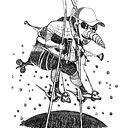by Vas Mylko
This post is about the philosophy behind Curiosio.
Terrain travel consists of urban and nature adventures. Time on the road splits between urban (thru populated areas, roadside infrastructure) and nature (scenic or non-scenic roads). In this post, I will focus on the urban side, only on cities.
Cities have POIs, worth to be visited, and along with POIs many cities have a unique vibe. Behind the vibe word I mean real human chemosignals, feelings, environment, the overall atmosphere. I will continue using the vibe word, meaning the overall perception of the city by a tourist.
What makes the vibe of the city? Immediately, you see, smell and hear it. If there are cool ongoing events, they could define the vibe during that time. If you stay for a while, you notice habits, daily behavior, people movement, design of everyday things. Let’s dissect city vibe into components, drill down to perception basics:
- Visual
- Audial
- Ambient
- Eventful
- Behavioral
- Design
- Unique
Visual
Pedestrian view or view from a car or bus/tram/train/cab is first. You grasp commonality and variability to what you’ve seen in other parts of the world. You need to see enough diversity, to build a personal model of the new location. So you view the city from different angles: architecture, streets, bridges, people, parks, squares, waterfronts, markets, transport, etc. Architecture defines so much, that after a while, you can identify the city by architecture only.

Cities have true curiosities. Ever been to Amsterdam? In Amsterdam, they have roof hooks. Those hooks stand out, they are present almost everywhere. The local name is hijsbalk. The function is to move furniture and home appliances thru the window. The reason is tall and narrow Dutch houses with tight and narrow staircases. It’s nearly impossible to move furniture or other large objects via staircases. And there are no elevators.
You could have a bird's-eye view of the city. From a skyscraper, tower, hill, mountain, helicopter, cable gondola, sometimes plane when it flies over the city for landing. A view from the top gives you a different perspective. You notice geometry — shapes, street patterns, street orientation, landscape. Street orientation, street patterns were beautifully visualized by Geoff Boeing. Then Vladimir Agafonkin made it interactive and colorful.


City shape could be defined by multiple factors — resisting attack, facilitating trade, moving people. Rail, roads, and real estate play a role in the physical shape of cities; so does geography. Open the tale of the five cities: Los Angeles, London, Shanghai, Manila, Lagos. Visualization is interactive and beautiful.

Visuals could be freaky. Here is Berlin from space. “Berlin at night. Amazingly, I think the light bulbs still show the East/West division from orbit.” — Chris Hadfield, Canadian astronaut.
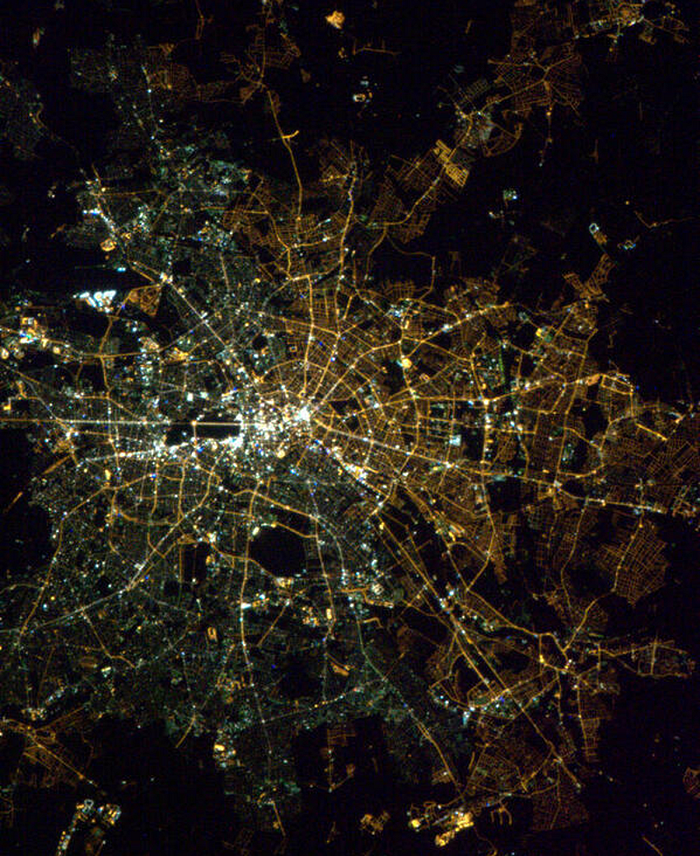
“…without a map and simply by remembering the visual appearance of the streets and turns along the way. As you gradually explored your neighborhood, you grew more confident, mastered your whereabouts and learned new and increasingly complex paths. You may have gotten briefly lost, but found your way again thanks to landmarks, or perhaps even by looking to the sun [or light bulbs] for an impromptu compass.” — DeepMind, “Learning to navigate in cities without a map”.
Skylines contribute to the city vibe. Go take a quiz, guess a skyline. Go try GeoGuessr, locate yourself using visual vibe approach.
Audial
You hear the city. Sounds could be so different: honking in Cairo, railway noise on Brighton Beach Ave, ambulance and fire sirens, car alarms, landing aircrafts, street music, wind, cicadas, people. There is whole sonic soup, but very often one type of sound stands out — it’s transportation noise. Urban Observatory shows multiple cities by a dozen of themes. Below is a comparison of transportation noise for New York City, Los Angeles, San Francisco.

Tod Machover combines music with technology at the MIT Media Lab. Check out intro and details at CityLab’s “Turning Street Noise Into a City Symphony”. First, Machover turned the sounds of Toronto and Edinburgh into symphonies that reflect the characters of each city. Then he asked Detroiters to record and upload sounds unique to the city — street drums, factories, spoken language by locals. Then he combined these sounds with instruments by the Detroit Symphony Orchestra. The result is known as Symphony in D.
Below is a link to “Symphony in D” itself. It is almost 38 minutes long. A good idea is listening to it after reading this post.
Ambient
It is hard to not notice that you are awake in friendly time zone, but it’s already dark skies for hours, e.g. in Stockholm in Autumn. PM hours are dark because of the shape and tilt of the planet. It is hard to not notice the absence of Sun in Andorra because there are mountains all around you. There are only narrow skies above you. It is hard to not notice any climate difference in comparison to what you are used too — light vs. dark, dry vs. wet, cold vs. hot, windy or quiet, yellow grass vs. green grass, weather and so forth.
A city could be flat like Copenhagen or Amsterdam with tons of people riding bicycles. A city could be hilly like San Francisco or Istanbul, with steep climbs difficult even for machinery. A city could be a monolithic piece of land or spread over islands. The central parts of Stockholm consist of fourteen islands that are continuous with the Stockholm archipelago. There could be canals like in Hamburg, Amsterdam or a big river like in London. New York City has a continental part, islands, and rivers.
Air contributes to the vibe a lot. Both visually and smelly. Air pollution is a real thing, it changes during a day, it is different across the cities. BreezoMeter shows air quality per city, using air quality index, with drill down into details. New York City real-time air quality could be checked here.

Smell vastly contributes to the vibe of the city. Manhattan, Paris, Mumbai all smell differently. Check out our older post about Parisian smell, scroll down to Cultural Curiosity section there.
Eventful
Events make the vibe. Significant events define the city during the event. E.g. SXSW in Austin during two weeks redefines Austin, Web Summit in Lisbon redefines Lisbon. Technological companies created platforms for events: Facebook Events, Google Maps Events. Google Maps is only rolling out the feature for users to create public events since late March 2019. When you wake up in a new city, it is a good idea to check out both Facebook and Google Maps for the events, and head to where people gather, to not miss the thing.
Events could be at city-scale, such as annual festivals, sports games, techno-sport (Monaco Grand Prix). City-scale events could be scheduled more frequently than once per year, such as concerts, exhibitions, initiatives. Events could be smaller than a city, e.g. the start of sales of new iPhone [when it was religiously anticipated] in Apple Store, or a celebrity in residence.
A celebrity in residence is so-called TEDification of travel — when artists, academics and assorted creative types are invited to stay for free. It is open to professional yoga instructors, surfers, photographers, dancers, etc., to come for a week. The only requirement is that they meet and mingle with guests, and contribute to the community in some way.
Events could be rare, though definitely not once in a lifetime experiences:
- Mystical cross halo aka sun dog, Solar eclipse, Moon eclipse, cloud iridescence, Manhattanhenge, meteors (Chelyabinsk meteor story), a huge iceberg drifted close to the city.
- Cruise liner half-sunk at the shore (Costa Concordia story), nude protesters on the main street, 7-month blockage of the Wall Street (Occupy Wall Street story).
- Provocative graffiti or mural, that is going to be removed (Haight Street Rat by Banksy story). Temporary installations, e.g. giant hands in Venice against global warming (Support by Lorenzo Quinn story)
- Opening of something cool (The Vessel in NYC story), a celebrity next to you watching the sunset in Machu Picchu, or even in The Vessel.
Events could be true once in a lifetime experiences. Such events are not predictable, not plannable, often dark. They are black swans, catch them in real-time:
- People tragedy: NYC 9/11.
- Landmark devastated: Notre-Dame on fire, World Trade Center twins NYC 9/11.
- Hudson water landing of US Airways Flight 1549.
- Big people gathering on central square or near a government building, a prequel to revolution (Kyiv 2014 story).
- Celebrity died, emotional tribute, pilgrimage (Apple Store in Tokyo story).
- King Kong escaped from zoo and climbed Chrysler Building (did not happen yet).
Behavioral
City vibe is dynamic. Even if nothing significant happens, people make it all. How people move, what people do on a daily basis, what exactly people do — this defines the vibe. Traditional breakfast in Vienna is a semmel and coffee. Once I [with friends] got a bag of fresh semmels on a door handle as breakfast in an Austrian village. We were still waiting for an hour or so for more. But that was it. Culture difference.
It is interesting to watch how people move in the city. People commute to work in the morning, then back home in the evening. People who live in the city move within the city. Various motion workers (delivery services, service workers) contribute to the big picture. There are distinctive motion patterns, depending on the people motion behavior. Below are four cities — Hong Kong, Copenhagen, Istanbul, New York City — with four motion modalities in each — transport, running, biking, walking. Check it out at Human.
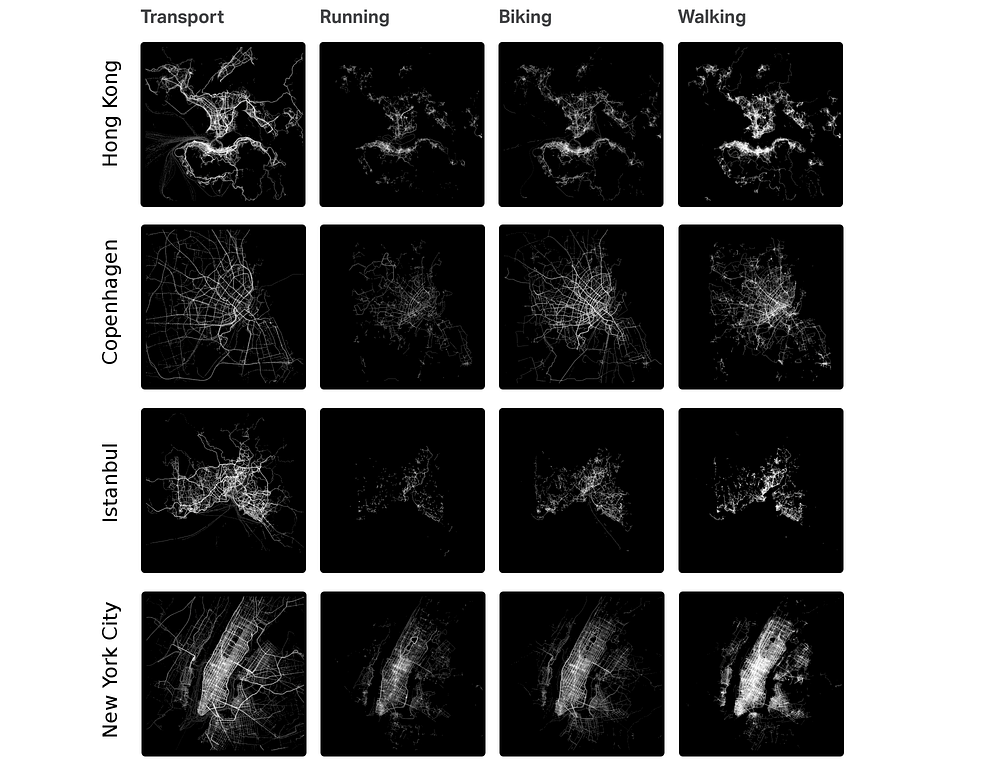
Other behavioral peculiarities are — left-hand drive vs right-hand drive, daily clothes habits, siesta in Barcelona, pubs and around pubs in London on Friday after 15:00, keeping windows not covered by curtains in Stockholm.
Design
For the layout, streets go back to Visual section. This section is about the design of everyday things, contributing to the vibe. Door handles, light switches and dimmers, windows types (how they open), bathroom and toilet, flatware. Scandinavian countries designed own interior style known as hygge.
Also trash bins, road signs, traffic lights, pedestrian walks, bike lanes, dog poop in parks and sidewalks (are there dispensers with paper bags?), street light (white or yellow, like in West/East Berlin, Europe vs. Asia vs. Americas), counters in shops and gas stations, renewal energy, ambient advertisement.
You could check honest everyday things at Dollar Street, such as showers, handwashing, doors, beds, toys, hallways, floors, kitchens, kitchen sinks cutlery, favorite home decorations, light sources, locks, parking lots, etc. The numbers in USD on the pictures below are income numbers, not price tags.

Unique
Previous sections were for humans, but this section is for geeks, real geeks. There are ~200 countries in the world. Within those countries there are ~500 cities with 1,000,000+ people, ~4,000 cities with 100,000+ people, ~400,000 inhabited places. Ultimate curiosity would be the unique identification of them. How to do it for humans? Here is how to do it for machines.
Rémi Louf and Marc Barthelemy from Institut de Physique Théorique examined the sizes and the shapes of the blocks in ~130 cities around the world. They wanted to classify/identify the cities by their blocks. Below are unique fingerprints of Tokyo vs. New York City, distilled from their blocks.
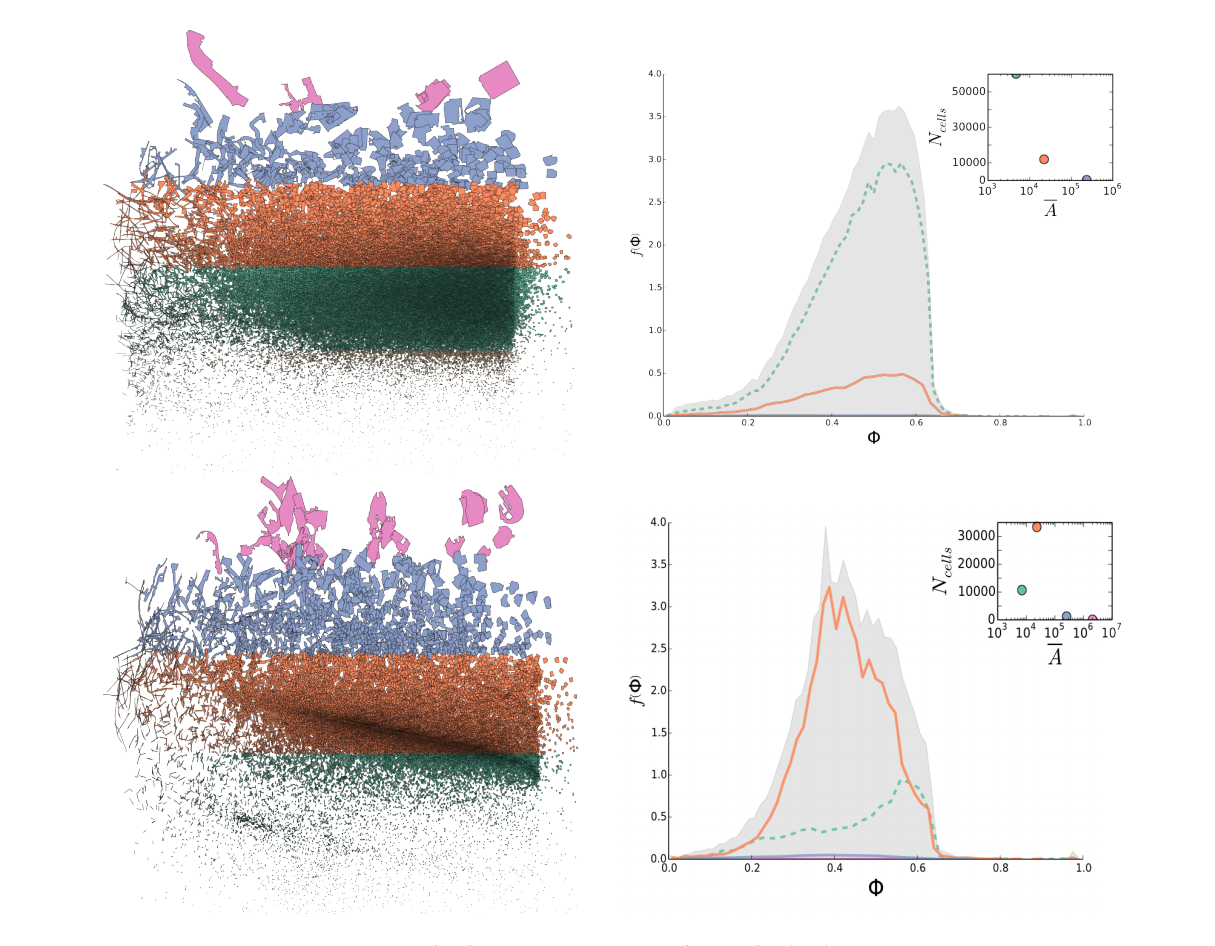
More in their research paper “A typology of street patterns”. Easier non-technical description available at Big Think “How to Fingerprint a City”. It’s possible to quantify and classify cities according to their street pattern. Conditional probability distribution of shape factor of blocks with a given area defines what could constitute the fingerprint of a city. Using clustering methods, these fingerprints can then serve as a basis for a typology of cities.
Curiosio
Curiosio is already handling a lot of the city vibe components today. More to come. Pay attention to the POIs recommended for each big city (we parsed only big cities). You will notice main thoroughfares and small pedestrian streets, central square and small squares, parks, cemeteries, cafes, street food, landmarks, markets, venues, waterfronts, galleries, towers, skyscrapers, hills, observatories, etc. All POIs are relevant by touristic value, whole trip is optimized by time & budget simultaneously in required geography. The vibe is there.
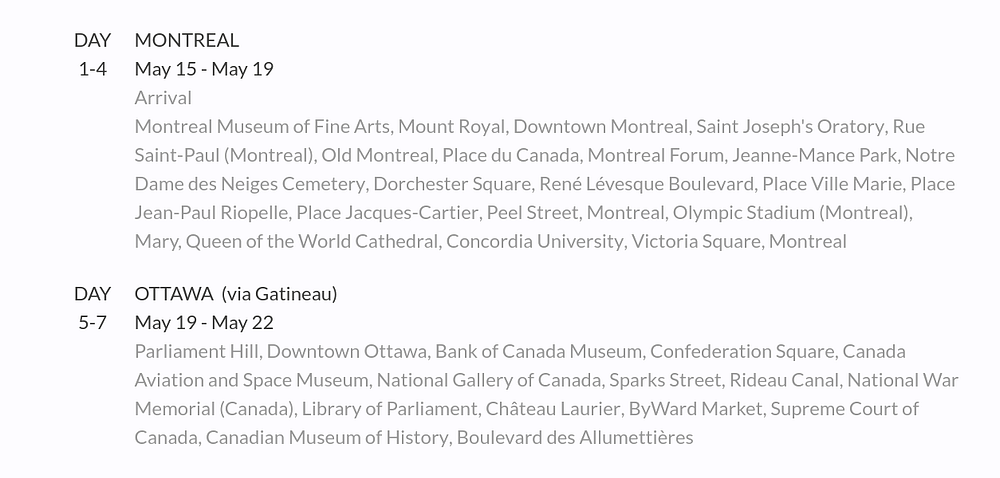
Big piece of work will be related to events. Within the Lab we already handle themed placeholders: gastronomic, concerts, nightlife, and others, a dozen of them. It’s all dynamic, there is a big difference in how to handle the vibe before a trip vs. during the trip. We are going to include this all into what a tourist perceives as a city vibe.
Play with Curiosio at https://curiosio.com. Stay curious, stay tuned.
